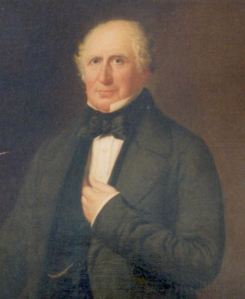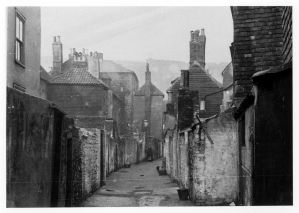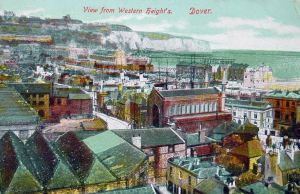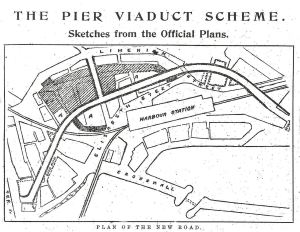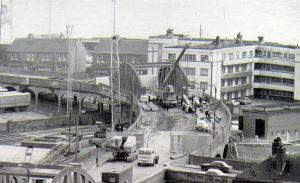
George Flashman made all the furnishings in the old Council Chamber, Maison Dieu, and on completion donated the Lectern in 1868.
The old Council Chamber in what was once Dover’s Town Hall – the Maison Dieu – was added in 1868. Flashman’s of Dover made the furnishings, many of which can still be seen. It was in the autumn of 1830 that George Flashman (1804-1885) opened a furniture making business at the corner of Market Square that was to dominate the east side of the Square for the next 150-years!
Born in 1804, George had served his apprenticeship as a cabinetmaker in his birthplace of Chatham. He came to Dover in the 1820s eventually teeming up with George Killick and opening a small business in Last Lane, on the west side of Market Square. At about this time, Dover Harbour Commissioners were increasing their income by building superior properties along the seafront, of which Waterloo Crescent is still standing. Castle Street was also being built for the more affluent residents of Dover by a consortium of local businessmen.
With the latter in mind, George bought premises on the north-east corner of Market Square and opened a shop making high-class furniture to the customers’ specifications. on the premises. At the time George bought his property Castle Street was not accessible from Market Square but in 1836, George sold some of his land for £350 to the council. This, along with the acquisition and demolition of other properties by the council, enabled Castle Street to be opened into Market Square. George changed his address to Castle Street and his business, in the prime spot, flourished.
George married Elizabeth Bridgland and they bought 79 Castle Street, on the opposite of the road to his shop. A religious man, George was active in the Wesleyan Church and later was appointed steward of the Dover Methodist circuit. This was the highest post a layman could hold and he held it for twenty-one years.

Church Place at the end of which was Flashman’s workshop and deposiary on Dieu Stone Lane, which can just be seen. Dover Library
As his business grew, George opened a furniture depot in Market Lane and a cabinet factory in Dieu Stone Lane. Later an annex was built next to the cabinet factory for the depository. Always the businessman and recognising an opportunity, with the approaching wedding of Queen Victoria to Prince Albert on 10 February 1840, George erected a large Royal Coat of Arms on his shop front. Underneath was the dedication, ‘Congratulations to her Royal Highness Queen Victoria & his Royal Highness Prince Albert’. This attracted a lot of interest to his shop, from the elite members of Dover’s society and visitors to Dover. Soon his fame spread such that members of the Royal family were ordering furniture from Flashman’s of Dover!
Between 1859 and 1862 was carried out on the Drop Redoubt, on the Western Heights, exposing the Bredenstone, the remains of a Roman Pharos. From 1660 successive Lord Wardens had been installed near the location but the building of the fortifications during the Napoleonic Wars (1793-1815) had buried the ancient ruin. On 29 August 1860 with all the pomp and ceremony that goes with the event Viscount Palmerstone, Prime Minister at the time, was installed as the Lord Warden of the Cinque Ports. Messrs Flashman were commissioned to erect a pavilion over the historic stone and the area where the ceremony took place.
Although a hard-headed businessman, George was well known for his generosity. On 3 March 1863 a fire, claiming three lives, devastated properties on the west-side of Market Square. George and Elizabeth took in and provided for one of the families that had been left homeless. Between 1852 and 1862, the Maison Dieu, then Dover’s Town Hall, was restored using the designs of Ambrose Poynter and carried out by William Burges. In 1867-8, the Council Chamber was added to the designs of Borough Engineer, John Hanvey in the style of Burges. George won the contract for the furniture and when completed he donated the lectern above.
As the nineteenth century progress the number of exclusive specialist shops increased along the east-side of Market Square. Of note were Killick, Back and Son’s carpet warehouse, linen store and clothing and Binfield Brothers. The latter were wine merchants. They had established about 1850 in Last Lane opening their newly built Market Square premises in 1889. Their shop was faced with Minton tiles and emblazoned with the Binfield trades mark of a rising sun and provided both a wholesale and a retail service in wines, spirits and tables waters. Binfield’s own blend of ‘old Scotch’ was sought after around the world.
Elizabeth Flashman died in 1867 and in the census of 1871, George was listed as living in Buckland with members of his immediate family nearby. On 22 May 1885 Mrs Mary Tyler, George’s eldest daughter, laid the foundation stone for the extension of Buckland School. George had contributed £225 towards the building but this was one of his last acts of generosity for he died that year aged 81-years.
By the time of George’s death the firm was well patronised by the elite of British Society. In acknowledgement to this George had replace the earlier plaque with one proclaiming that his company had been given a Royal Warrant. This was hung over the entrance to the shop. After George’s death his sons and son-in-law continued to run the business. In 1893 the company designed and built a new stage proscenium for theatre productions at the Connaught Hall but it was not until after World War II that theatrical productions were allowed to be staged in the Hall.
Following the death of Queen Victoria in 1901, the Royal Warrant plaque was moved to the inside the shop and replaced by another proclaiming the different aspects of the enterprise. Their adverts proclaimed that they were high-class decorators, auctioneers and house agents and that their premises had an acre of floor space that would completely furnish a house. ‘The floor space was stocked with cabinets, curtains bedsteads, bedding, bedroom suites, linoleum, rugs, curbs and fire brasses plus over eight miles of carpets in stock, many being private patterns!’

Thomas Longley Landlord of the Star, Church Street. At his death, reputed to be the heaviest man on the Realm. Bob Hollingsbee
The firm were also funeral directors and in 1904 Flashman’s made the 7-foot (2.13metres) long by 2-feet 9inches (0.96metres) wide by 2-feet 5inches (0.74 metres) deep coffin for Thomas Longley. He had been the landlord of the Star Inn, Church Street. When he died, on 26 February that year, Longley was reputed to be the ‘heaviest person in the realm.’
World War I and the depression of the 1920s seem to have passed Flashman’s by. On 1 November 1930, the firm held its centenary celebrations by which time their workshop on Dieu Stone Lane was extensive. The also had large retail outlets Folkestone and St Margaret’s Bay as well as Dover. Headed by Chairman and Managing director, Clement Flashman. The business claimed that they could cater ‘from the cradle to the end.‘ There was every reason to believe this as their clients were amongst the wealthiest in the land.
During his speech that night, Clement showed a large Crown with wreaths and ribbons beautifully carved out of mahogany. It was part of a bedstead that the company had recently made for the Royal Family. However, acknowledging changes in public taste and the economic climate of the time, Clement added that the firm was increasingly making smaller, compact utilitarian furniture at considerable less cost but still more than the man-in-the -street could afford to pay.
Even though the economy sunk to even lower depths, because of their clientele base, Flashman’s could weather it. Albeit, Arthur Binfield put his wine shop on the market in 1937. The business sold for £4,300, Arthur died in 1966 aged 74.
Unlike World War I, the Second World War had a devastating impact on Flashman’s not only from the business perspective. On 31 March 1941, their furniture depository, in Dieu Stone Lane, was damaged by fire following a shell attack. Another shell totally wrecked the building on 4 October 1943. That year their main premises in Market Square suffered from shelling that seriously injured a passer-by. The shop and adjacent buildings suffered further war damage and the latter had been demolished by 1945. In their place, a NAAFI Institute, built of Nissen huts and capable of accommodating 1,500, opened on 19 March 1945.
In 1953 Dolphin House, comprising of flats and eight shops were built on the bombsite. Flashman’s refurbished their shop and when the economy started to recover, in the 1950s, the firm did their best to respond. By 1956, they boasted of largest stock of furniture, carpets etc. on the south-coast and published a 36 page illustrated catalogue, free by post. Albeit, very few people could afford to buy bespoke furniture and the stop-go economy was taking its toll on the furnishing business (See the Turnpenny story)
New shops opened on the east-side of Market Square but were very different to their pre-war counterparts. Elizabeth’s was Dover’s first coffee bar and was seen by parents as a ‘safe’ place for teenagers to enjoy ‘expresso coffee’ and other teenagers company. My memory is of a later era and a restaurant providing conventional meals but with speciality ‘snack’ foods that I loved. The owner, Douglas Horne, was attracted by the Wimpy franchise. It was in 1954 that J Lyons opened the first UK Wimpy fast food outlet in London, the concept having been imported from the US. Soon Wimpy bars were opening up throughout the country, usually franchised to local entrepreneurs. Douglas Horne bought into the scheme and the Wimpy franchise opened on the east-side of Market Square on Tuesday 29 November 1966 with Hugh Gordon as manager.
Two years before, in November 1964, Flashman’s had closed its doors for the final time. The building was soon after demolished to make way for a proposed £250,000 modern skyscraper with a two-storey department store at the bottom and ten-storeys of flats above. In the event, a supermarket, with flats above, was built. British Heart Foundation Charity has occupied the shop premises since 2005. However, Flashman’s furniture still fetch high prices at auctions.
Before demolition the Flashman famous Coat of Arms were removed and eventually found its way to St Nicholas Church in Leeds village, near Maidstone. The church guide states:
‘Under the tower arch is an early Victorian royal coat of arms carved in mahogany by Mr Flashman, who owned a furniture shop in The Square, Dover. It once stood over the entrance to this shop. It was given to Leeds church in 1968’
The plaque below the Arms adds:
‘The Royal Arms presented by their daughter in memory of Albert & Florence Cheeseman, Choirists of this church for many years. December 1969’
Published:
- Dover Mercury 31 October,07 & 14 November 2013
For further information on Castle Street : http://www.castlestreetsociety.co.uk
















